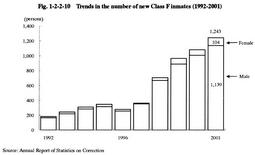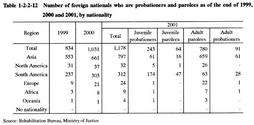| Previous Next Index Image Index Year Selection | |
|
|
4 Correction and rehabilitation of foreign offenders (1) Correction of adult offenders As for the correction of adults, the number of foreign nationals newly imprisoned was 1,862 in 2001, increasing by 159 (9.3%) from the previous year. "The foreign nationals who need treatment programs different from those for Japanese inmates" are called Class F inmates, and those who are new inmates and need treatment programs different from those for Japanese inmates are called "New Class F inmates" (hereinafter the same in this subsection). Fig. 1-2-2-10 shows the trends in the number of new Class F inmates in the last 10 years. The number of new Class F inmates has increased rapidly since 1998, and the index regarding 184 persons of new Class F inmates in 1992 as 100 reached 676 (1,243 persons) in 2001.
By offense for new Class F inmates in 2001, the number of larceny cases (481 persons, 38.7%) was the highest, followed by Stimulant Drug Control Law violations (184 persons, 14.8%), Immigration Control Law violations (174 persons, 14.0%), robbery (125 persons, 10.1%), Narcotics Control Law violations (34 persons, 2.7%), and homicide (28 persons, 2.3%) (Source: Annual Report of Statistics on Correction). As of December 31, 2001, the number of Class F inmates is 2,315 (2,176 for males, 139 for females)(Source: Correction Bureau, Ministry of Justice). Fig. 1-2-2-10 Trends in the number of new Class F inmates (1992-2001) (2) Rehabilitation of offenders In 2001, the number of newly received foreign nationals who are parolees and probationers (excluding permanent residents whose nationalities are South Korean, North Korean, and Chinese), was 730, an increase of 29.2% from the previous year. In terms of probation/parole type, the number of adult parolees was the highest, numbering 419 persons, followed by juvenile probationers (237 persons), juvenile parolees (51 persons, and adult probationers (23 persons)(Source: Annual Report of Statistics on Rehabilitation).
Fig. 1-2-2-11 shows the trends in the number of foreign nationals who are probationers and parolees (excluding permanent residents and special permanent residents) in the last 10 years. In 2001, the total number, which had continued to rise sharply since 1992, increased by 147 (14.3%) to 1,178 from the previous year. In terms of the index regarding 1992 (121 persons) as 100, it shows 974 in 2001. Table 1-2-2-12 shows the number of foreign nationals who are probationers and parolees by nationality and by probation/parole type as of the end of 1999, 2000 and 2001. In 2001, the number of persons who came from the Asian region was the highest and accounted for 67.7%, followed by 26.5% of persons who came from the South American region, and these 2 together exceeded 90% of the total number of foreign nationals who are parolees and probationers. Fig. 1-2-2-11 Trends in the number of foreign nationals who are probationers and parolees (1992-2001) Table 1-2-2-12 Number of foreign nationals who are probationers and parolees as of the end of 1999, 2000 and 2001, by nationality |


